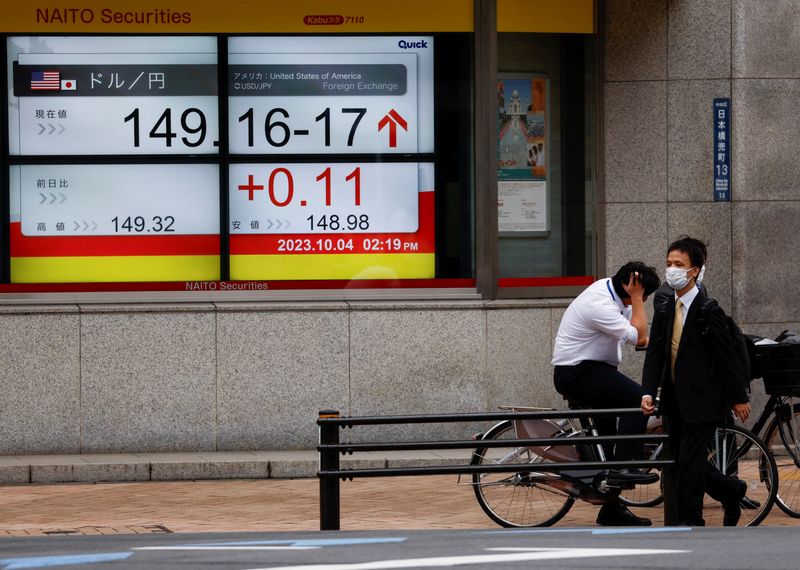

© Reuters. Passersby walk past an electric monitor displaying the Japanese yen exchange rate against the U.S. dollar outside a brokerage in Tokyo, Japan October 4, 2023. REUTERS/Issei Kato/File Photo
By Tom Westbrook
SINGAPORE (Reuters) -Japanese stocks hit a near 34-year high on Wednesday while other Asian equities meandered around one-month lows and bond markets traded cautiously ahead of U.S. inflation data due this week.
– which had its best year for a decade in 2023 – climbed 2% to break above 34,000 for the first time since 1990.
Exporters led the charge, helped by a softening yen. The broader also hit its highest since 1990.
The rally contrasts with China, where the blue chip CSI300 slid to a five-year low and pulled MSCI’s index of Asia-Pacific shares outside Japan down 0.7% to its lowest since mid-December.
steadied after spiking when an unauthorised post from the U.S. Securities and Exchange Commission’s X account said it had approved bitcoin exchange-traded funds. [.N][US/][FRX/]
U.S. equity futures were steady. European futures and futures slipped 0.2%. Australian inflation came slightly cooler than expected and focus was on U.S. consumer price data due on Thursday.
Interest rate futures are pricing around 140 basis points of U.S. rate cuts this year, compared to the Federal Reserve’s dot plot of 75 bps. The probability of a move as early as March has been pared somewhat to a still-high 64%, and will likely shift again depending on Thursday’s report.
“Market pricing…has gotten a little bit ahead of itself,” Jeff Klingelhofer, co-head of investments and managing director at Thornburg Investment Management, told journalists on an outlook call on Wednesday.
“If you look at history – five (25 bp) cuts is very consistent with a recession, but markets aren’t pricing in a recession,” he said. A lot … of the assumptions for 2024 would be historically very not normal if we get that.”
Forecasts are for core CPI to rise 0.3% in December, pulling annual inflation down to 3.8% and its lowest since mid-2021.
Geopolitical tensions were also on the radar as disruptions in the Red Sea and a production outage in Libya raised oil prices, and an election looms in Taiwan.
U.S. and UK forces shot down 21 drones and missiles fired by Yemen-based Houthis on Tuesday into the Southern Red Sea towards international shipping lanes, the U.S. military’s Central Command said.
futures rose 1.9% on Tuesday and were up 0.4% to $77.91 a barrel early on Wednesday. [O/R]
Bitcoin was last down 0.1% at $46,000 after spiking as high as $47,897 on the false reports of ETF approvals.
DATA DEPENDENT
Trade in foreign exchange and fixed income markets was tentative ahead of the U.S. inflation report.
Benchmark 10-year Treasury yields rose 1.5 bps overnight and were steady at 4.02% in Tokyo on Wednesday. The U.S. dollar held small gains, buying 144.83 yen and trading at $1.0933 per euro.
The dollar was little moved at $0.6701 after data showing Australian inflation slowed to a near two-year low, since it reinforced market expectations interest rates would not need to rise any further. [AUD/]
“It’s now time for cuts, but global growth expectations don’t point to a global recession,” said analysts at TD Securities in a note to clients.
“Our global growth indicators have improved, suggesting further USD downside through H1. However, it won’t be a straight line, especially as geopolitics will feature heavily on the market calendar this year and markets remain data dependent.”
Chinese lending figures are also due this week, with 2023 lending expected to have hit a record high as China keeps policy accommodative. Though there are expectations of further easing, there’s little sign of a shift in investors’ dour sentiment.
China’s blue-chip CSI300 index made a five-year low in morning trade, while the dropped 0.8% to a one-month low and the yuan hit its weakest since Dec. 13. [.SS][.HK][CNY/]
“Despite cries that Chinese/HK equity is cheap, we see no signs that international managers are prepared to step in and buy these markets with any conviction,” said Chris Weston, head of research at brokerage Pepperstone.
“It seems the drip-fed approach to policy easing and support just isn’t cutting it and the market wants a shock-and-awe approach.”






